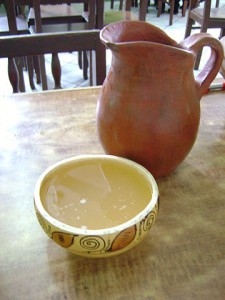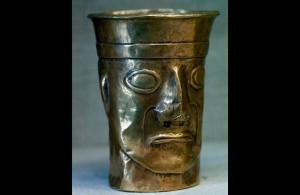Evolution
As time went on in the Andes, chicha only gained more importance for cultures there. Due to many cultures having maize of their own, the concept of chicha and its brewing techniques spread and evolved. From the original chicha made by the Kuna, the influence of the drink spread across many parts of South America – and ultimately into the Inca Empire’s culture. Maize was an important crop on its own, sacred for its place in myths and beliefs.
Importance for the Inca
Maize was grown on huge local and state farms, the majority being on terraced hill slopes and irrigated valley plains, designated specifically for the crop. This work was largely powered by chicha; the local populaces carried out the work in exchange for chicha and other benefits from their rulers. Chicha was often consumed after a day of hard work farming the corn, fostering an atmosphere of community and celebration

“Clarito en poto2” by Dtarazona – Source: commons.wikimedia.org (Traditional serving kero; a ceramic used by Andean commoners to serve their chicha.)
Chicha was offered to the gods and ancestors of the Inca through different rituals and ceremonies. In important rituals, the Sapa Inca, or king, participated. Chicha offering cups were usually made of gold or bronze with inlay of silver and precious gemstones.
The maize beer also played a part in death and sacrifices. Human sacrifices were rubbed in chicha and tube-fed chicha while they laid in tombs. People would also offer maize flour and chicha to the mummies of dead kings, leaders, and other elite to appease their spirits.
Chicha was also important due to its effects of intoxication. For the Inca, as well as many other cultures, drunkenness was a way to communicate with otherworldly beings, spirits, or even gods. The act of getting drunk also represents aspects of togetherness and community – to the Inca, sharing a drink with another person was seen as an act of friendship and understanding.

Photograph by Bates Littlehales – Source:http://science.nationalgeographic.com/ (A typical cup used by the elite to offer chicha.)
Sources:
1. McGovern, Patrick, professor of anthropology at University of Pennsylvania Museum in Philadelphia www.penn.museum/sites/biomoleculararchaeology/?page_id=147
2. Sherzer, Joel. Stories, Myths, Chants, and Songs of the Kuna Indians. Austin: University of Texas Press, 2003. Print.
3. Hackner, Stacy L., María Cecilia Lozada, and Augusto R. Cardona. “Us and Them: Molle and Maize Beer in the Prehistoric Andes.” (n.d.): n. pag. Web. <http://www.academia.edu/2642918/_Us_and_Them_Molle_and_Maize_Beer_in_the_Prehistoric_Andes_with_MC_Lozada_and_AR_Cardona>.
4. Owen, James. “Lost Inca Gold–Ransom, Riches, and Riddles.” National Geographic. N.p., n.d. Web.